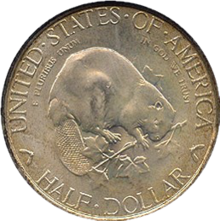United States | |
| Value | 50 cents (0.50 US dollars) |
|---|---|
| Mass | 12.5 g |
| Diameter | 30.61 mm (1.20 in) |
| Thickness | 2.15 mm (0.08 in) |
| Edge | Reeded |
| Composition |
|
| Silver | 0.36169 troy oz |
| Years of minting | 1936 |
| Mintage | 25,013 including 13 pieces for the Assay Commission (7,342 melted) |
| Mint marks | None, all pieces struck at Philadelphia Mint without mint mark. |
| Obverse | |
 | |
| Design | Beaver |
| Designer | Gertrude K. Lathrop |
| Design date | 1936 |
| Reverse | |
 | |
| Design | Thomas Dongan, Pieter Schuyler, and Robert Livingston |
| Designer | Gertrude K. Lathrop |
| Design date | 1936 |
The Albany Charter half dollar, also known as the Albany-Dongan half dollar or Albany half dollar, is a commemorative half dollar struck by the United States Bureau of the Mint in 1936. It was designed by sculptor Gertrude K. Lathrop, who lived in Albany, New York's state capital.
In 1936, Congress approved many commemorative coins for issuance, including some of mostly local significance. These included the Albany piece, wanted by city officials to mark the 250th anniversary of the 1686 grant of its municipal charter by Thomas Dongan, governor of colonial New York. The authorizing bill passed through Congress without opposition, though amendments added protections for coin collectors against abuses seen in earlier commemorative issues. Lathrop's designs have generally been praised: she placed a beaver on one side of the coin, modeled from life (one appears on Albany's city seal) and depicted the persons involved in the grant of the charter on the other. After approval of the designs by the Commission of Fine Arts, the Philadelphia Mint coined 25,013 Albany half dollars in October 1936, including 13 pieces for testing by the Assay Commission.
By the time of issuance, the demand for commemorative coins was falling, and the issue price of $2 was considered high. More than 7,000 were returned to the Mint in 1943, and a hoard of over 2,000 was sold by a local bank in 1954 at the original issue price. As of 2018[update], the Albany half dollar prices in the low hundreds of dollars, but the original packaging, if undamaged, may sell for more.